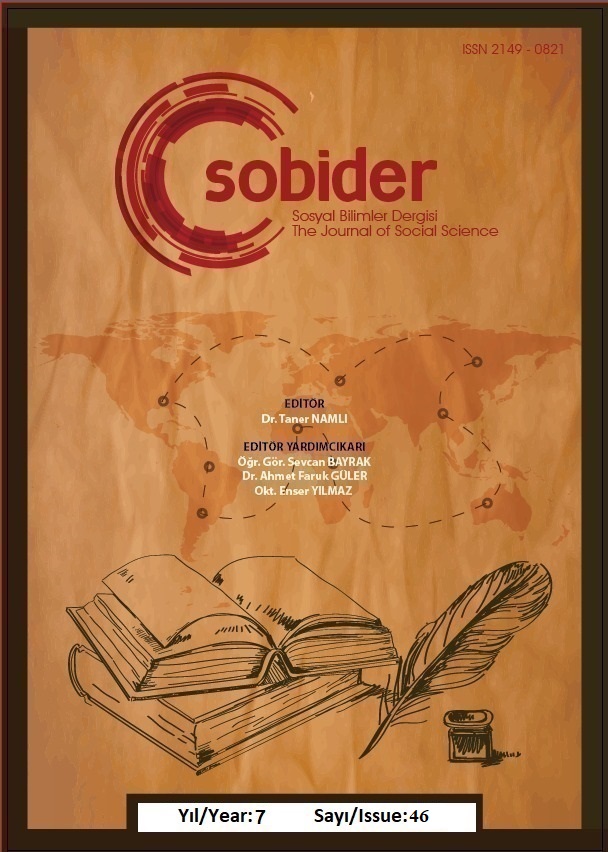Author :
Abstract
Teke Yöresi müzik kültürü içinde yaşatılan ve Yörüklerin yaşamlarının bir parçası olan İkitelli, Orta Asya Türk kültüründe telli sazların atası olarak kabul edilen kolca kopuzdan çeşitlenerek günümüze kadar kullanılagelmiştir. Burdur ilinin Çavdır ilçesine bağlı Kozağaç kasabası ve çevresinde yaygın olarak kullanılan İkitelli, yörede cura veya Kozağaç curası olarak da bilinmektedir. Gurbet havalarının icrasında özellikli bir yeri olan İkitelli, akort düzeni ve icra şekline bağlı olarak çoksesli bir icra yapısı sergilemektedir. Çalışma sürecinde, gurbet havası örneğinden yola çıkılarak, İkitellinin icrasında oluşan çoksesli yapılanma incelenmiştir. Söz konusu gurbet havasının seyrinde, kısa ve uzun kalışlar yapılan perdelerle birlikte diğer teldeki perdelerin belirli bir düzen içinde ezgiye katılması sonucu homofonik çoksesli yapı ortaya çıktığı; bu bağlamda, Türk müziği çokseslendirme anlayışında yer alan 1-4-5 vb. akor yürüyüşlerinin oluştuğu görülmüştür. Ayrıca, bu çoksesli yapının -Kemal İlerici’nin ilk olarak ortaya koyduğu- Dörtlü armoni sistemi ile de ortak yönlerinin olduğu tespit edilmiştir.
Keywords
Abstract
Ikitelli (two sittrings) has been preserved in the musical culture of the Teke Region and has been a part of the life of the nomads. It has over time evolved out of kolca kopuz, the ancestor of the stringed instruments in Turkish culture and has been used up to the present day. Ikitelli, which is widely used in and around the town of Kozağaç in the Çavdır district of Burdur province, is also known as the cura or Kozağaç cura in the region. It has a special place of importance in the performance of melodies that pertain to absence from home and offers a polyphonic form of performance depending on the tuning order and performance style. This study relies on a sample of homesick melody to examine the polyphonic structures that are formed in the performance of the Ikitelli. It has been observed that, throughout the course of the melody, frets on which long and short stays are made and the frets on the other strings contribute to the melody in a certain order to bring about a homophonic-polyphonic structure. In this context, the formation of chord progressions such as 1-4-5, which have a place in the Turkish polyphonic sound conception, have been observed. Also, this polyphonic structure has been seen to share common features with the system of quartal harmony -originally put forward by Kemal Ilerici.
Keywords
- Ayyıldız, S. (2013). Teke Yöresi Yörük Türkmen Müzik Kültüründe Yerel Çok Seslilik Özellikleri, Yüksek Lisans Tezi, İstanbul Teknik Üniversitesi Sosyal Bilimler Enstitüsü, İstanbul.
- Ekinci, A. (2018). Kişisel Görüşme, Burdur.
- Emnalar, A. (1998). Tüm Yönleriyle Türk Halk Müziği ve Nazariyatı. Ege Üniversitesi Devlet Türk Musikisi Konservatuarı.
- Gazimihâl, M., R. (1975). Ülkelerde Kopuz ve Tezeneli Sazlarımız, Kültür Bakanlığı MİFAD Yay. 15, Üniversite Basımevi, Ankara.
- İlerici, K. (1970). Bestecilik Bakımından Türk Müziği ve Armonisi. Milli Eğitim Basımevi,
- Koruk, Ç. (2009). Teke Yöresinde Kullanılan Telli Çalgıların Müzikal ve Teknik Analizi. Yüksek Lisans Tezi, Haliç Üniversitesi Sosyal Bilimler Enstitüsü, İstanbul.
- Ögel, B. (1987). Türk Kültür Tarihine Giriş IX, Kültür ve Turizm Bakanlığı Yayınları, Başbakanlık Basım Evi, Ankara.
- Parlak, E. (2000). Türkiye’de El ile (Şelpe) Bağlama Çalma Geleneği ve Çalış Teknikleri. Kültür Bakanlığı Yayınları, Ankara.
- Say, A. (2002). Müzik Sözlüğü, Müzik Ansiklopedisi Yayınları, Ankara.
- Sümer, F. (1972). Oğuzlar (Türkmenler) Tarihleri – Boy Teşkilatı – Destanları. (2. Baskı). Ankara Üniversitesi Basımevi, Ankara.
- Uludağ, E. (2009). Teke Yöresi Müzik Kültüründe İkitelli Kozağaç Curası, Yüksek Lisans Tezi, Haliç Üniversitesi Sosyal Bilimler Enstitüsü, İstanbul.





